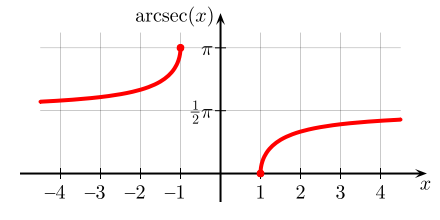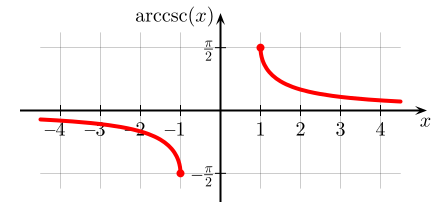Arkussekans und Arkuskosekans sind zyklometrische Funktionen. Sie sind die Umkehrfunktionen der Sekansfunktion bzw. der Kosekansfunktion und damit Arkusfunktionen. Da die Sekans- und die Kosekansfunktion periodisch sind, wird zur Umkehrung der Definitionsbereich von Sekans auf  , und der Definitionsbereich von Kosekans auf
, und der Definitionsbereich von Kosekans auf  beschränkt. Der Arkussekans wird mit
beschränkt. Der Arkussekans wird mit  bezeichnet und der Arkuskosekans mit
bezeichnet und der Arkuskosekans mit  . Seltener, vor allem aber im Englischen verwendet man auch die Schreibweisen
. Seltener, vor allem aber im Englischen verwendet man auch die Schreibweisen  und
und  ; sie bedeuten aber nicht, dass
; sie bedeuten aber nicht, dass  bzw.
bzw.  die Kehrwerte von
die Kehrwerte von  und
und  sind.
sind.
Eigenschaften
| | Arkussekans | Arkuskosekans |
Funktions-
Graphen |  |  |
| Definitionsbereich |  |  |
| Wertebereich |  |  |
| Monotonie | In beiden Abschnitten jeweils streng monoton steigend | In beiden Abschnitten jeweils streng monoton fallend |
| Symmetrien | Punktsymmetrie zum Punkt  | Ungerade Funktion  |
| Asymptoten |  für für  |  für für  |
| Nullstellen |  | keine |
| Sprungstellen | keine | keine |
| Polstellen | keine | keine |
| Extrema | Minimum bei  , Maximum bei , Maximum bei  | Minimum bei  , Maximum bei , Maximum bei  |
| Wendepunkte | keine | keine |
Reihenentwicklungen
Die Reihenentwicklungen von Arkussekans und Arkuskosekans sind:


Integraldarstellungen
Für den Arkussekans und Arkuskosekans existieren folgende Integraldarstellungen:


Ableitungen
Die Ableitungen sind gegeben durch:


Integrale


Umrechnung und Beziehungen zu anderen zyklometrischen Funktionen


Siehe auch
- Formelsammlung Trigonometrie
- Trigonometrische Funktionen
Weblinks
- Eric W. Weisstein: Inverse Secant und Inverse Cosecant auf MathWorld
Trigonometrische Funktion











































